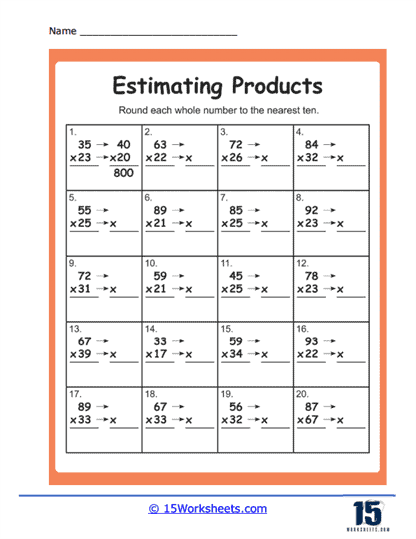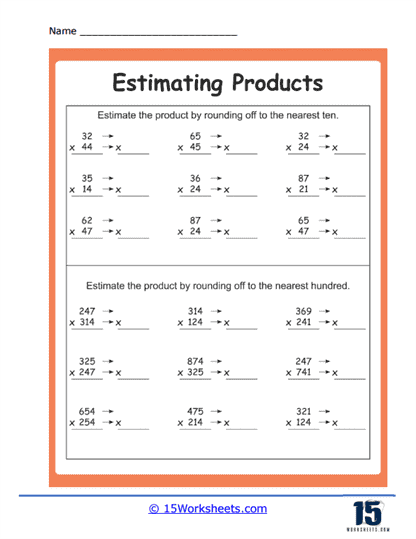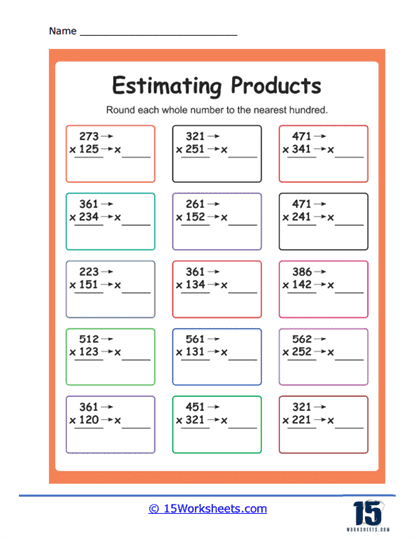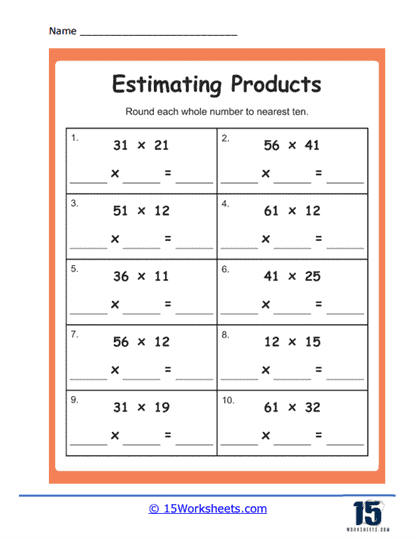Estimating Products Worksheets
About These 15 Worksheets
Estimating products refers to the process of finding an approximate result of the multiplication of two or more numbers, rather than the exact result. By rounding the numbers to the nearest tens, hundreds, or other convenient values before multiplying, we can simplify the operation and make it much quicker to perform, especially in mental calculations. You probably use this skill everyday and do not even realize it.
You will find these types of problems over this collection of worksheets:
Basic Estimation – These exercises involve estimating the product of two simple numbers. For instance, if asked to estimate the product of 23 and 47, you might round 23 to 20 and 47 to 50, then multiply them to get an estimated product of 1000.
Estimating Products with Large Numbers – In these problems, you’ll estimate the product of larger numbers. For example, to estimate the product of 375 and 220, you could round 375 to 400 and 220 to 200, then multiply to get an estimated product of 80,000.
Multiple Operations – These exercises combine multiple operations. You might need to add, subtract, or divide numbers, and then estimate the product. For instance, you might first subtract 132 from 256, and then estimate the product of the result and 78.
Decimal Estimation – These problems involve estimating the product of numbers that include decimals. For example, to estimate the product of 4.9 and 3.1, you might round 4.9 to 5 and 3.1 to 3, then multiply to get an estimated product of 15.
Estimating Products with Fractions – These exercises involve fractions. For instance, you might be asked to estimate the product of 7/8 and 16. Here, you could round 7/8 to 1 and estimate the product as 16.
Now, where does estimating products come into play in your everyday lives? Here are some examples:
Shopping – If you’re buying several identical items, you might need to estimate the total cost. For example, if you’re buying 5 T-shirts each priced at around $19.95, you could round that price to $20 and multiply to estimate a total cost of $100.
Cooking and Baking – Recipes often require you to multiply, especially when adjusting the number of servings. If a recipe for 4 people calls for 1.5 cups of flour and you want to cook for 8 people, you could estimate that you’ll need approximately 3 cups of flour.
Home Improvement – If you’re painting a room and you know that one can of paint covers approximately 400 square feet, you can estimate the number of cans you’ll need based on the size of your room.
Travel Planning – If you’re planning a trip and know the approximate cost per day, you can estimate the total cost based on the number of days you’ll be traveling.
Environmental Conservation – If you’re trying to reduce your electricity usage and you know your TV uses around 0.1 kWh per hour, you can estimate the electricity used by multiplying this number by the approximate number of hours you watch TV each day.
These worksheets are far from just another assignment – they’re an invaluable tool that’ll help you breeze through many real-world scenarios with ease. The ability to quickly estimate products aids in swift decision-making and problem-solving, skills that are useful in many aspects of life. So embrace these worksheets and the world of estimation they open up.















